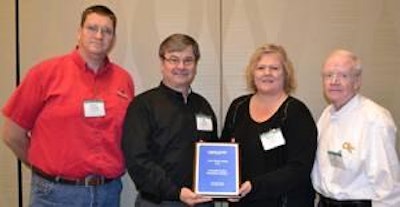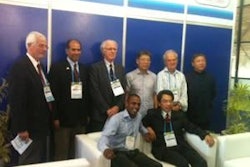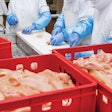
As the leading supplier of sliced sandwich meat to Subway restaurants across the country, West Liberty Foods is on the cutting edge when it comes to large-scale, state-of-the-art advanced meat processing. The company’s commitment to being an industry leader in ready-to-eat meat processing extends beyond the processing floor at its Mount Pleasant, Iowa, facility and into the plant’s environmental wastewater pretreatment system, which was a key factor in earning the facility the U.S. Poultry & Egg Association’s 2012 Clean Water Honorable Mention Award in the pretreatment category.
West Liberty’s production
West Liberty Foods, LLC, West Liberty, Iowa, is the 11th largest turkey producer in the U.S. and is responsible for annually supplying customers with 340 million pounds of RTE turkey, chicken, pork, beef and other products.
Producing 3.9 million pounds of RTE meat products each week at four facilities located in West Liberty, Sigourney and Mount Pleasant, Iowa, and Tremonton, Utah, West Liberty Foods’ 1,920 employees work closely with their business partners and customers to deliver an ever changing array of RTE meat products.
Mount Pleasant facility
In 2003, West Liberty Foods greatly expanded its capacity to produce RTE meat products by opening an 84,000-square-foot facility in Mount Pleasant. With an annual output capacity of 200 million pounds and 470 employees, the Mount Pleasant plant produces a variety of RTE turkey, chicken and beef products. The Mount Pleasant facility handles over 500,000 pounds of product each processing day, generating 650,000 gallons of high strength process wastewater (approximately 1.3 gallons of wastewater generated per pound of meat processed) in the process. The wastewater stream is pretreated on-site prior to discharge into the City of Mount Pleasant’s municipal sewer system.
Clean Water Award honorable mention
When the USPOULTRY 2012 Clean Water Awards judging team initially reviewed the 20 months of process wastewater effluent data submitted by West Liberty Foods for the Mount Pleasant facility, the team wondered why so much performance data existed for a wastewater pretreatment system that only had an environmental regulatory permit limit for one parameter: biochemical oxygen demand. Pretreatment plant data showed that Mount Pleasant wastewater treatment system staff routinely monitor, in addition to BOD, chemical oxygen demand, total suspended solids, total Kjeldahl nitrogen, oil and grease and total phosphorus.
By the time the Clean Water Award judging team completed its site visit of the Mount Pleasant facility, it was apparent that West Liberty Foods' commitment to leading the RTE meat industry permeates the entire company culture, including its wastewater pretreatment plant performance, a corporate standard of continued improvement in all environmental impact areas, and the adoption of advanced wastewater treatment technologies.
Pretreatment plant performance
As shown in Table 1, the Mount Pleasant plant’s local environmental regulatory pretreatment permit has a concentration (mg/L) and loading (lb/day) limit for only BOD (200 mg/L and 167 lb/day monthly average). Over the two-year period encompassing 2010 and 2011, the Mount Pleasant facility utilized only 22 percent of its concentration BOD permit limit (monthly average of 43 mg/L) and 26 percent of its loading BOD permit limit (monthly average of 26 lb/day). However, as Table 1 also shows, the Mount Pleasant plant tracks and calculates monthly averages for the facility’s effluent discharge of COD (127 mg/L and 79 lb/day), TSS (64 mg/L and 40 lb/day), O&G (6 mg/L and 4 lb/day), TKN (10 mg/L and 6 lb/day), and TP (24 mg/L and 15 lb/day).
“Many industrial wastewater treatment facilities narrow the focus of their plant performance to only the parameters on their discharge permits ...” said the late Jim Walsh, senior research engineer at the Georgia Institute of Technology and member of the USPOULTRY Clean Water Awards Committee. “... but too many companies forget that permits change over time. If you don’t have any baseline data on parameters that aren’t on your permit, you’ll be behind the curve if and when they do show up on a future permit. The environmental team at Mount Pleasant understands this and has put the facility ahead of the curve for the future.”
Continued environmental improvement
The company’s West Liberty facility was the first turkey plant in the U.S. to receive an ISO 14001 certification. Soon after, both the Mount Pleasant and Tremonton plant also received ISO 14001 certification. ISO 14001 is part of a family (ISO 14000) of internationally accepted standards that provides a framework for companies to establish, operate, evaluate and continually improve an effective Environmental Management System. The standards were developed in 1996 by the International Organization of Standardization. The ISO 14001 standard specifies requirements for an EMS to enable an organization to develop and implement a policy and objectives that take into account legal requirements and other requirements to which the organization subscribes, and information about significant environmental aspects. It applies to those environmental aspects that the organization identifies as those which it can control and influence. It does not itself state specific environmental performance criteria.
Adoption of new technology
The Mount Pleasant facility utilizes two novel wastewater treatment technologies. The first is Clean Water Technology’s Gas Energy Mixing system of dissolved air flotation. “Although the GEM system fits within the definition of DAF, it differs in many ways from the typical DAF system used in most poultry processing plants,” Walsh said. These differences include operating recycling rates and pressures. Typical DAF systems used today in poultry processing plants recycle between 25 percent and 50 percent of the effluent flow for re-pressurization at 70 psi. The GEM system does not utilize a recirculation loop and thus pressurizes 100 percent of the wastewater flow at 100-120 psi.
Another major difference between the GEM and traditional DAF systems is the utilization of liquid solid gas mixing heads in the GEM systems in place of the pressurized serpentine tubes seen in typical DAF systems. Each GEM system comes with six LSGM heads plumbed in series, each with an independent point of injection and mixing. Each head can be adjusted to a specific mixing energy to balance the physical nature of the wastewater stream with the associated chemistry (flocculants, pH, etc.) to produce the optimum solids removal.
Finally, the footprint of a GEM unit compared to a relatively sized traditional DAF unit is dramatically decreased. This is because the flocculation of the wastewater contaminants occurs within the LSGM heads prior to release into the skim tank. Thus, the GEM system eliminates the retention time required in conventional DAF systems. “For us, the system just made a lot of sense,” said Michele Boney, West Liberty Foods environmental compliance officer, “especially from a footprint standpoint. The pretreatment facility isn’t that large, and a majority of the space is taken up by the biological system. The GEM system handles a lot of flow, but only takes up a small space in our pretreatment building.”
Biofilm reactors remove contaminants
Another novel wastewater treatment technology utilized by the Mount Pleasant facility are two EEC High-Speed Bio Tec moving bed biofilm reactors. The moving bed biofilm reactors process is based on the utilization of attached aerobic biofilms that take advantage of activated sludge biological treatment in stabilizing and removing insoluble organics and other contaminates in wastewater without being restrained by the major disadvantages of large footprint and high sludge production.
Moving bed biofilm reactors use thousands of polyethylene biofilm carriers operating in suspension within an aerated wastewater treatment basin. Each individual biocarrier provides surface area to support the attachment and growth of beneficial bacteria. This creates a high-density population of bacteria that can achieve high-rate contaminant stabilization within the system. The biofilm that is created on the surface of each biocarrier protects the bacterial cultures from operational upsets and provides a buffer to deal with process wastewater fluctuations.
“We see very limited application of biological treatment in poultry processing pretreatment plants,” said Walsh, “which is most often due to footprint. Most biological treatment systems require a large biomass and a large hydraulic capacity. Because an MBBR can provide the same treatment efficiencies as we see in large activated sludge plants in a much smaller space, it makes sense.”
As the judging team exited the Mount Pleasant wastewater pretreatment facility, Walsh was overheard saying, “Wow, how big is that building? Maybe 10,000 square feet? They’re running an internal rotary screen, a DAF system and an MBBR, pretreating 650,000 gallons of high-strength wastewater every day in that little building ... that’s impressive.”















